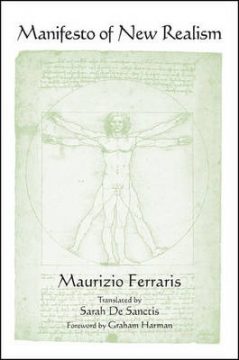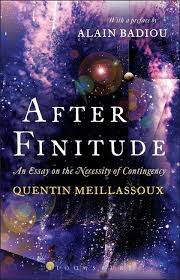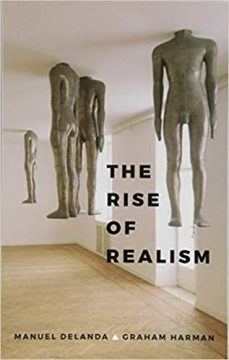by Dave Maier

“Realism” is a word with many senses. In politics, it’s synonymous with pragmatism in being the alternative to idealism, which it considers naive. In science, realists oppose instrumentalism and (extreme forms of) empiricism, positing a reality behind the phenomena of empirical investigation. In philosophy as well, one can be a realist about this or that by resisting the reduction of that or this phenomenon to other things thought more ontologically basic.
Mainly, though, philosophical realism is metaphysical realism, an ontological commitment to a basic reality irreducible to, and independent of, mind, belief, language, social conventions, empirical observations – whatever you got. On this side of the pond, realism has generally been considered the default position, but analytic philosophy was born in linguistic analysis and a robust strain of empiricism, so various sorts of antirealism have remained popular here as well.
On the Continent, however, things are different. Analytic philosophy was a revolt against a post-Hegelian tradition which remained dominant in Europe, and in the last third of the previous century, when postmodernism ruled supreme, continental realists hardly dared even show their faces in public. At least, that’s the story now being related by a new breed of continental realist. Now that postmodernism is yesterday’s (or last week’s) news, realism is popping up all over.
If postmodernism was nonsense on stilts, then a return to common sense can only be good. But analytic antirealists, at least, aren’t just dimwits or charlatans, and we shouldn’t simply identify substantive philosophical claims, however intuitive, with mere sanity; and continental realism, it turns out, comes in a bewildering variety of forms. Before sounding the hosannas, and awarding the palm to realism at last, we owe this new development a closer look.
– – –
Graham Harman (no relation, I don’t think, to philosopher Gilbert Harman, whose views I have occasionally been accused of sharing) is the most visible new realist, with several books and a vigorous internet presence, but is not, as he acknowledges, the first. In a foreword to Italian philosopher Maurizio Ferraris’s book Manifesto of New Realism (2014), Harman tells us that Ferraris had seen the light (“in a flash,” during a lecture by hermeneutic philosopher Hans-Georg Gadamer) by 1992, and Ferraris describes the book as a summary of the last twenty years of his thoughts on the subject, putting him at what we might as well call the beginning.
As Ferraris notes, the context of this turn to realism is all-important, and he means his book to be an explicit response to three “crucial points” of postmodernist dogma:
1) Ironization: taking a theory seriously shows a form of dogmatism, and we should therefore maintain an ironical detachment toward our statements.
2) Desublimation: the idea that desire constitutes as such a form of emancipation, because reason and intellect are forms of dominion, and liberation must be looked for through feelings and the body, which are revolutionary per se.
3) [“most of all”] Deobjectification: the assumption that there are no facts but only interpretations, as well as its corollary for which friendly solidarity should prevail over an indifferent and violent objectivity. [p.4]
If the wording of (1) and (3) didn’t already suggest it, footnotes confirm that Richard Rorty (as well as Nietzsche, whose infamous note §481 of The Will to Power is quoted in its entirety without further comment) is a prime target. (That of (2) turns out to be Gilles Deleuze, not usually thought to be a major postmodernist; we’ll come back to him later.)
In response, Ferraris lists several overlapping features of the real world which should restore our faith in facts [before, I quoted; here I paraphrase]:
1) Ancestrality: briefly, the real world can’t be socially constructed, because it was here before anyone was around to construct it. (We will see a subtler version of this argument below.)
2. Unamendability: we cannot change reality by the “mere use of conceptual schemes” (there is an entirely spurious citation of Wittgenstein’s remark about “bedrock” here). A corollary: if we could indeed do so, things would be better (unless we’re “masochists”).
3. Similarly, “we can well imagine experiences that occur without language”: I can slip on the ice without having that concept.
4. Being and knowing (ontology and epistemology) are not the same; the alleged postmodern opposite, again, is Nietzsche: (“there are no facts, only interpretations”).
5. the world is (not simply unamendable by, but) completely external to “conceptual schemes.” This seems to be directed at Kantians: “The constructionist claims that if fire burns […] it all depends on conceptual schemes. It is clearly not so […] It depends on the fact that fire burns […] I can know (or ignore) all I want; the world is what it is.” [pp. 32-3]
These are all things which realists can be expected to say, and they may indeed be familiar from the realism debates on our own shores. Also familiar, unfortunately, is the suggestion, throughout the book, that refuting postmodernism, and establishing realism in its place, is a matter simply of a) alluding to common understandings of postmodernists as facile idealists and/or relativists (or, as with Nietzsche, quoting the alleged proof-text without further comment), and b) restating everyday trivialities in response. This better not be all there is to new realism, or we’re wasting our time.
– – –
As it turns out, we can indeed do better. Another writer Harman namechecks as a prime mover in the new realist movement is French philosopher Quentin Meillassoux. While superficially similar to Ferraris’s Manifesto, Meillassoux’s After Finitude spends rather less time abusing postmodernism, devoting most of its pages to a rigorous, detailed argument for a fairly specific – although indeed decidedly realist – metaphysical position. This requires confronting what Meillassoux calls “correlationism,” which consists, he tells us, in
disqualifying the claim that it is possible to consider the realms of subjectivity and objectivity independently of each other [… that is, that not only do] we never grasp an object ‘in itself’, in isolation from its relation to the subject, but […] we can never grasp a subject that would not always-already be related to an object. [p.5]
 In most new-realist writing that I have seen, “correlationism” functions as an all-purpose term of abuse, applying not only to the usual idealist and postmodern suspects but also, as one writer has it, to “hermeneutics, Wittgensteinian philosophy, pragmatism, analytic anti-realism, existentialism, etc.” Meillassoux himself does refer to correlationism as “the central notion of modern philosophy since Kant,” but in this formulation, while – or because – more substantive than Ferraris’s triviality, the rejected idea seems to represent a fairly specific post-Kantian constructivism rather than mere resistance to metaphysical realism in general (not, of course, that Meillassoux would be happy with that either). Whether this is indeed the case will depend on what it means, for example, to “grasp” things (or “encounter,” or “think” them), but let’s move on.
In most new-realist writing that I have seen, “correlationism” functions as an all-purpose term of abuse, applying not only to the usual idealist and postmodern suspects but also, as one writer has it, to “hermeneutics, Wittgensteinian philosophy, pragmatism, analytic anti-realism, existentialism, etc.” Meillassoux himself does refer to correlationism as “the central notion of modern philosophy since Kant,” but in this formulation, while – or because – more substantive than Ferraris’s triviality, the rejected idea seems to represent a fairly specific post-Kantian constructivism rather than mere resistance to metaphysical realism in general (not, of course, that Meillassoux would be happy with that either). Whether this is indeed the case will depend on what it means, for example, to “grasp” things (or “encounter,” or “think” them), but let’s move on.
Meillassoux takes similar care in unpacking his prime argument, familiar in its crude form from above, from “ancestrality.” He grants that his idealist opponent will affirm the empirical triviality that the world existed before we got here – if someone had been there to see it, then they would indeed have seen it, and its empirical reality need not depend on its actually being seen – but the idealist will also add a “codicil” that this triviality need not imply the existence of a real world preceding “givenness itself,” which, whatever exactly that means, is unacceptable to Meillassoux’s project.
In this formulation, the argument from “ancestrality” is thus fairly involved, and it’s not entirely clear where exactly we end up, but it does at least seem to transcend mere abuse, albeit without convincing me that such an argument can uproot, in one go, the “correlationism” allegedly common to great swaths of philosophy – indeed, virtually everything since Kant – in favor of what, again, seems like a fairly specific metaphysical end (the subtitle of After Finitude is An Essay on the Necessity of Contingency, not Why Realism is True After All).
In any case, while it’s easy for me as someone resisting traditional Cartesian metaphysical realism to ignore crude anti-postmodern abuse, as deployed in support of realistic trivialities, it’s less easy for me to shrug off as irrelevant a detailed argument which purports to establish something not only explicitly advertised as “pre-critical,” but which also sounds a lot like the sort of unpleasantly dualistic picture found in Descartes. Indeed, it seems that Meillassoux’s main disagreement with Descartes is not with the latter’s industrial-strength dualism but with his dogmatism, in for example appealing to God’s supposed non-deceptive nature to get us out of his self-imposed skeptical predicament (and, beyond that, to a conception of the absolute which depends crucially on the concept of necessity). On the other hand, especially since I’m already happy to allow something like “the necessity of contingency” (not to mention the possibility of substantive metaphysics in general), I’m not in a big hurry to finish this book.
– – –
 Finally, let’s meet Graham Harman himself, here in conversation with another continental realist, Manuel Delanda. This book, called The Rise of Realism (I recommend the Kindle edition, so you don’t get weird looks on the subway; see cover at right), is particularly enlightening for a couple of reasons. First, while condemning “correlationism” (no surprise there), Harman and Delanda (hereinafter HD) say quite a bit more about what “realism” might mean. Second, while agreeing that there is a “real world” in some strong sense, they disagree quite a bit with each other (and with Meillassoux for that matter) about what sorts of thing that real world contains. Delanda, for example, virtually equates “realism” with (his brand of) “materialism,” while Harman has written articles like “I Am Also of the Opinion that Materialism Must Be Destroyed.” Harman’s short-lived group of “speculative realists” (also including Ray Brassier, Levi Bryant, and Iain Hamilton Grant) disbanded for similar reasons a few years ago.
Finally, let’s meet Graham Harman himself, here in conversation with another continental realist, Manuel Delanda. This book, called The Rise of Realism (I recommend the Kindle edition, so you don’t get weird looks on the subway; see cover at right), is particularly enlightening for a couple of reasons. First, while condemning “correlationism” (no surprise there), Harman and Delanda (hereinafter HD) say quite a bit more about what “realism” might mean. Second, while agreeing that there is a “real world” in some strong sense, they disagree quite a bit with each other (and with Meillassoux for that matter) about what sorts of thing that real world contains. Delanda, for example, virtually equates “realism” with (his brand of) “materialism,” while Harman has written articles like “I Am Also of the Opinion that Materialism Must Be Destroyed.” Harman’s short-lived group of “speculative realists” (also including Ray Brassier, Levi Bryant, and Iain Hamilton Grant) disbanded for similar reasons a few years ago.
Following Lee Braver’s exposition (in his 2007 book A Thing of This World: A History of Continental Anti-Realism), HD list six theses about which one might come down on the side of realism or antirealism:
R1/A1: The world is not/is dependent on the mind.
R2/A2: Truth is/is not correspondence.
R3/A3: There is/is not one true, complete description of how the world is.
R4/A4: Any statement is/is not necessarily either true or untrue.
R5/A5: Knowledge is/is not passive with respect to what it knows.
R6/A6: The human subject does/does not have a fixed character.
To these, Harman adds:
R7/A7: The relation of the human subject with the world is not/is a privileged relation for philosophy.
Harman complains about A7 a lot: “correlationists,” he believes, are so committed to the “for-us” that they never consider that there are plenty of other things out there which are not human subjects, and that the relations between those things don’t depend in any way on our own capacities. As he notes, one could, with Kant apparently, believe both R1 and A7; so already we have a subtler, if potentially more inconclusive, treatment than we have seen previously.
Next, Delanda adds:
R8/A8: The world is not/is a holistic entity in which everything is inextricably related.
Delanda takes Deleuze – a primary influence – to be an R8 (and thus not the “postmodernist” Ferraris thinks him to be), identifying R8 with the doctrine of relations being external to their terms, a concept central to both of HD, although the metaphysical results for each, as noted, are quite different. (Briefly, Harman believes in individual essences (preceding, and thus not exhausted by or reducible to, the relations engaged in by individual objects), while Delanda endorses a (post-) Deleuzian ontology of “flows” or “flux.” It’s less clear to me how this requires a doctrine of “external relations,” or R8, but that doctrine is indeed something that Deleuze himself says all the time, so there’s that.)
Delanda adds one final thesis, citing Derrida as an example:
R9/A9: Subjective experience is not/is linguistically structured.
It follows from A9, according to Delanda, that “each culture lives in its own world, and that there is not one real world that we all share,” which certainly sounds like antirealism, even if I’d require more explication of at least four terms here before I’d accept R9 (I guess “is” is okay, but maybe that’s up for grabs too!).
So, points to HD for their careful (if not, as I believe, comprehensive) review of our options here, and I recommend this book as an excellent resource (warning: it gets rather technical, and indeed over my own head, in spots). I will content myself here with a single potential gripe, to wit: I wonder if perhaps the entire presentation tilts the playing field toward realism.
If this discussion is to arrive at a substantive conclusion, the R-statements can’t simply be trivially true. If they were, we’d all agree on them, congratulating ourselves on putting nonsense behind us; but once the party was over we’d be pretty much where we started (minus the loons). There would turn out to be different kinds and degrees of “realism” (in addition, as here, to differences about which things are the real ones).
In any case, that’s not how HD present it. Here’s Harman on R1: “The great likelihood that the universe pre-existed humans has enough prima facie plausibility that any philosophy denying it has a heavy burden to carry.” If there’s only a “great likelihood” that it’s true, it’s not a triviality; but how “heavy” is that burden supposed to be? That is, what exactly would A1 be denying?
To their credit, HD take this problem seriously, and spend some effort trying to get clear on the exact sense of “independence” they mean (as clear, that is, as is possible without a non-realist in the room to press them). Once that’s settled, though, it’s easy for the careful disambiguation to fall away. R1 means that the world is independent, full stop; and now we must choose it or its opposite, and bring in, as perhaps not definitive evidence, but perhaps only showing a “great likelihood” of truth, the fact that “the universe pre-existed humans.” But is that the triviality it seems, or something apparently more substantive, as in Meillassoux? The deck still seems rhetorically stacked: any balking at R1 means you don’t think the world preceded us, and how crazy is that?
In my view, it would be better to explain R1-R8 and A1-A8 as not necessarily simply contradictory, leaving space for us to reject both (or accept both, for that matter). After all, R4 (bivalence) is, I take it, not supposed to be a triviality, so we shouldn’t just be assuming it (note that we leave open the possibility of picking one or the other each time, thus not assuming A4 either).
In other words (or relatedly, anyway), we might wonder whether R1-8 are themselves to be realistically construed. HD’s procedure here is in line with the typical realist assumption that self-reference can only be a problem for relativists (relativism isn’t true-for-me, so ha; but is realism true? Yes!). However, this only follows with realism already in place (think about it).
Back to the positive, though: I have already learned quite a bit from this book, and I am interested in hearing more from Delanda in particular, whose “realism” – depending, again, on what exactly these “flows” turn out to be – may not, in practice anyway, be any impediment. So stay tuned!
